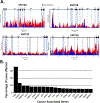COMPASS Ascending: Emerging clues regarding the roles of MLL3/KMT2C and MLL2/KMT2D proteins in cancer
- PMID: 31128216
- PMCID: PMC6638576
- DOI: 10.1016/j.canlet.2019.05.024
COMPASS Ascending: Emerging clues regarding the roles of MLL3/KMT2C and MLL2/KMT2D proteins in cancer
Abstract
The KMT2 (lysine methyltransferase) family of histone modifying proteins play essential roles in regulating developmental pathways, and mutations in the genes encoding these proteins have been strongly linked to many blood and solid tumor cancers. The KMT2A-D proteins are histone 3 lysine 4 (H3K4) methyltransferases embedded in large COMPASS-like complexes important for RNA Polymerase II-dependent transcription. KMT2 mutations were initially associated with pediatric Mixed Lineage Leukemias (MLL) and found to be the result of rearrangements of the MLL1/KMT2A gene at 11q23. Over the past several years, large-scale tumor DNA sequencing studies have revealed the potential involvement of other KMT2 family genes, including heterozygous somatic mutations in the paralogous MLL3/KMT2C and MLL2(4)/KMT2D genes that are now among the most frequently associated with human cancer. Recent studies have provided a better understanding of the potential roles of disrupted KMT2C and KMT2D family proteins in cell growth aberrancy. These findings, together with an examination of cancer genomics databases provide new insights into the contribution of KMT2C/D proteins in epigenetic gene regulation and links to carcinogenesis.
Keywords: Chromatin; Co-occurrence; Epigenetic; Lysine methyltransferase.
Copyright © 2019 Elsevier B.V. All rights reserved.
Conflict of interest statement
Conflict of interest statement:
The authors declare that they have no conflict of interest.
Figures



Similar articles
-
The cancer COMPASS: navigating the functions of MLL complexes in cancer.Cancer Genet. 2015 May;208(5):178-91. doi: 10.1016/j.cancergen.2015.01.005. Epub 2015 Jan 30. Cancer Genet. 2015. PMID: 25794446 Review.
-
Hijacked in cancer: the KMT2 (MLL) family of methyltransferases.Nat Rev Cancer. 2015 Jun;15(6):334-46. doi: 10.1038/nrc3929. Nat Rev Cancer. 2015. PMID: 25998713 Free PMC article. Review.
-
The MLL3/4 H3K4 methyltransferase complex in establishing an active enhancer landscape.Biochem Soc Trans. 2021 Jun 30;49(3):1041-1054. doi: 10.1042/BST20191164. Biochem Soc Trans. 2021. PMID: 34156443 Free PMC article. Review.
-
Biochemical perspectives on targeting KMT2 methyltransferases in cancer.Trends Pharmacol Sci. 2021 Aug;42(8):688-699. doi: 10.1016/j.tips.2021.05.002. Epub 2021 May 30. Trends Pharmacol Sci. 2021. PMID: 34074527 Review.
-
Aberrant Activity of Histone-Lysine N-Methyltransferase 2 (KMT2) Complexes in Oncogenesis.Int J Mol Sci. 2020 Dec 8;21(24):9340. doi: 10.3390/ijms21249340. Int J Mol Sci. 2020. PMID: 33302406 Free PMC article. Review.
Cited by
-
Genetic and therapeutic landscapes in cohort of pancreatic adenocarcinomas: next-generation sequencing and machine learning for full tumor exome analysis.Oncotarget. 2024 Feb 5;15:91-103. doi: 10.18632/oncotarget.28512. Oncotarget. 2024. PMID: 38329726 Free PMC article.
-
Association of KMT2C Genetic Variants with the Clinicopathologic Development of Oral Cancer.Int J Environ Res Public Health. 2022 Mar 27;19(7):3974. doi: 10.3390/ijerph19073974. Int J Environ Res Public Health. 2022. PMID: 35409657 Free PMC article.
-
Insights into the mechanisms driven by H3K4 KMTs in pancreatic cancer.Biochem J. 2024 Aug 7;481(15):983-997. doi: 10.1042/BCJ20230374. Biochem J. 2024. PMID: 39078225 Free PMC article. Review.
-
Transcriptional co-activators: emerging roles in signaling pathways and potential therapeutic targets for diseases.Signal Transduct Target Ther. 2023 Nov 13;8(1):427. doi: 10.1038/s41392-023-01651-w. Signal Transduct Target Ther. 2023. PMID: 37953273 Free PMC article. Review.
-
The roles of histone modifications in tumorigenesis and associated inhibitors in cancer therapy.J Natl Cancer Cent. 2022 Sep 28;2(4):277-290. doi: 10.1016/j.jncc.2022.09.002. eCollection 2022 Dec. J Natl Cancer Cent. 2022. PMID: 39036551 Free PMC article. Review.
References
Publication types
MeSH terms
Substances
Grants and funding
LinkOut - more resources
Full Text Sources
Molecular Biology Databases
Miscellaneous

